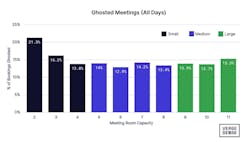Calculating the Cost of Space Inefficiencies
Facilities and workplace teams today face complex challenges, from making informed space management decisions to optimizing cost per square foot and ensuring employee satisfaction.
Sensors have ushered in a new era in which data can guide tricky decisions. And it has—for some.
Facilities and workplace professionals are faced with a number of data challenges—too much, too little, the wrong tools, incongruence across locations. To avoid inefficiencies—wasted resources, costs, and negative employee experience—our advice is to just get started with what you have available to you. The key to adopting data-driven decision-making is about the mindset.
You can (and likely already do) calculate some data points to evaluate solutions to thorny space challenges. Calculating the cost of space inefficiencies, in particular, offers valuable insights for any team.
Remove the Guesswork
Data allows workplace and facilities teams to step away from emotionally charged debates about space allocation and usage. Instead, it provides clear, objective insights that can inform more effective strategies.
Consider the case of a top consulting firm overwhelmed with complaints about conference room availability. The workplace team initially considered leasing an additional floor to create more meeting spaces. However, booking data revealed that 40% of current room reservations were being ghosted—consultants booked the rooms, but didn’t show up to use them. Releasing unused spaces opened up space for consultants and created a cost-avoidance opportunity for the leasing strategy.
Align Space and Business Needs
New hybrid work policies mean something different to every organization, and the physical space supporting these policies hasn’t caught up. Data can be key to realigning space with evolving business needs. Applying a monetary value to space inefficiencies can help change the perspective and drive decisions.
Take the example of a software company with 30 offices but a predominantly remote workforce. Data showed that one smaller office averaged only two people per day despite costing $115,000 annually. That perspective made the decision to close that location straightforward and impactful.
In another example, a financial services institution was considering a design change. Data showed that although teams needed collaboration space, they also required individual workspaces for privacy. Evaluating inefficient space led the team to increase privacy by adding acoustical elements to collaboration spaces, adjust table sizes in two-person cubbies, and repurpose six-person conference rooms into open work points for three people. The team achieved $280,000 in annual savings.
Define Metrics
Conducting your own office audit will allow you to see which spaces are being used most effectively and which present an opportunity for adjustments. Here are a few data points you can consider to support your analysis:
What is your threshold for efficiency? Determine what efficiency looks like for your business and the space. For example, if your space has a capacity of 100 people, but your goal is to maintain average usage of no less than 40 and no more than 80 people, then 40% to 80% capacity usage is the target threshold.
How much does your space cost per square foot/meter? If you don’t already have this on hand, calculate the cost per square foot of your space by dividing the total cost of rent or mortgage by the square footage/meters of your office space to get this number.
What are your core working hours? Traditionally, working hours are Monday through Friday, 9 a.m. to 5 p.m., but we know that key space demand patterns have changed and will vary depending on your business's workstyles and policies. Analyzing space based on core hours helps paint a more accurate picture to plan, manage, and design space. For example, your core needs for space might be Tuesday through Thursday between 10 a.m. and 3 p.m.
Once you have target efficiency, cost per square foot, and core working hours defined, you can begin analyzing space inefficiencies and understand the financial impacts.
Calculate Inefficiency
Let’s use our example from above. If your threshold for efficient capacity usage is 25% to 80%, then any space with time usage below 25% within working hours would be considered under-utilized.
Let’s say you have an open collaboration space that is 1,000 square feet and has a capacity of 10. If your lease is $44 per square foot annually, that means this open collaboration space costs $11,000 per year (square footage of space multiplied by cost per square foot). The business has identified that using collaboration spaces at less than 25% of the capacity on average is inefficient.
While you can’t sublease or remove a targeted space within your lease, it is important to understand these inefficiencies and the impact on costs. If you have five areas within your office that are being underutilized, that’s leaving a lot of money on the table.
What’s Next: Implement Tactical Solutions
Leveraging your data to identify underutilized spaces will open doors. This is the first step to identifying the opportunity cost. Next, consider interventions for replacing inefficiencies with spaces that are in demand.
How much are you losing on over-sized meeting rooms? When conference rooms are built for eight people, but only three use the space on average, how much space is being used inefficiently?
Is there a specific space type going unused even during core hours? Looking at peak space usage, which space types aren’t being used, and how much does that cost you?
Evolution Over Revolution
A cybersecurity company knew they needed to adapt their office design to accommodate employee needs. Instead of a costly full-floor redesign, the workplace team used data to identify inefficiencies and added 50 two-person phone booths across the office. This solution not only satisfied employees’ needs but also saved an estimated $1.5 million in buildout costs.
While not all space inefficiency stories involve such dramatic savings, adopting a data-driven mindset is a powerful strategy for navigating today’s workplace challenges. Start small, but start now.
About the Author
Izzy Cannell
Izzy Cannell is a member of the VergeSense Strategic Advisory Services team (SAS), which offers consulting services exclusively to VergeSense customers, providing a blend of design thinking and data-driven approach to optimize your workplace data strategy.
Izzy supports customers in leveraging the insights that lead to actionable improvements to their workplace strategy, bridging the gap between workplace data and strategy. Previously, Izzy led Data Strategy for Twitter's Real Estate & Workplace team. Prior to that, Izzy led Workplace Intelligence and Workplace Strategy projects as a consultant at Cresa and Avison Young's professional services offerings.
Brad Golden
Brad Golden is a member of the VergeSense Strategic Advisory Services team (SAS), which offers consulting services exclusively to VergeSense customers, providing a blend of design thinking and data-driven approach to optimize your workplace data strategy.
Brad designs applied data strategies to transform insights into action with VergeSense’s Fortune 500 customers. Previously, he worked with Herman Miller and Steelcase where he was trained by IDEO in Human-Centered Design.

